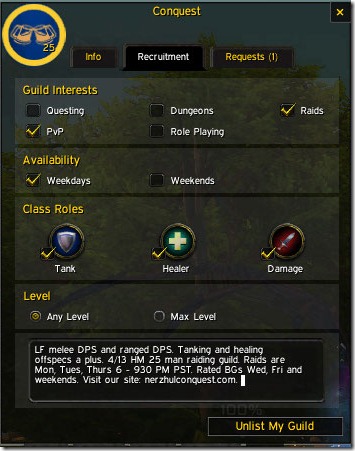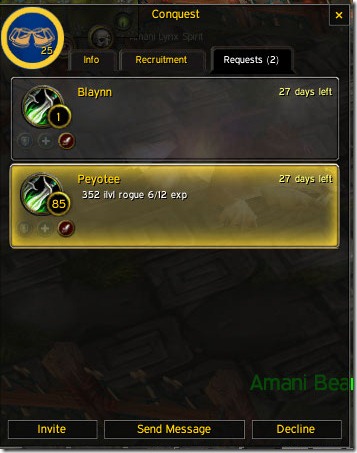With Conquest taking down Throne of the Four Winds and Theraliona on heroic mode, we find ourselves now at 7/13 hard modes for progression (We could also greatly use another Rogue or Warlock).
At that progress level, I’ve had to make slight adjustments to our recruiting requirements. Namely, gear that was good enough to get through normal mode bosses such as players with a mix of crafted epics, reputation epics and other blue heroic quality gear just won’t be enough anymore. With the way the lockouts presently work, we only tackle heroic bosses. There aren’t that many normal mode bosses that we can really take on lest it compromise our progression. We generally don’t downgrade heroic bosses to normal because we usually take them down within a couple of attempts.
Because of this, we’ve raised our gear requirements from an average item level of 345+ to 356+. Why? Because we can’t spare the time and effort to go back through and “carry” players to get gear upgrades. Our directive is to go progressive and look forward. Granted, because of this, there’s going to be a slight gap. Players that draw in will continue to get to gear and I also need to take care that the players who are sitting on the side get rotated in the week after so they can get practice and shots at gear as well.
But how can I get better if I don’t get to raid?
Therein lies the kicker. As a player on the outside looking in, that player needs to do well enough to draw into the lineup. From there, they’re off to the races. But as a raid progresses through the different bosses, the minimum requirements will go up. What may have passed as above average months ago may not be good enough now. If there was one thing I missed about having access to separate 10 man raid instances, it would be the capability to gear players on the side during the weekend. The success of pickup raids on vary wildly from server to server. I get lucky joining 5/6 clears in Blackwing Descent on my alt Ret Paladin. Not everyone is so fortunate in getting in.
Player patience
The other thing I notice is that player patience drops the moment we take something down on farm. I know my guys tolerate the first 20 – 40 learning wipes. Once we get a fight down once or twice, people get agitated if we wipe more than 2 or 3 times. Wiping more than that is inevitable if we pull in several newer players who haven’t taken down the fight yet (much less seen it at work). I counter this by placing them in the most easiest and least stressing of roles. I don’t try to switch up the tanks unless it’s extremely urgent (such as a missing tank). I’ll place new and less experienced healers on raid healing duties until they see enough of the encounter for me to get them to specialize in certain positions (Tank healing, or kiter healing or tackling the stupid Rohash platform on heroic mode).
I face pressure from the veterans from trying to get through the stuff we’ve taken down on a timely fashion to get moving onto the stuff we haven’t seen.
On the other hand, I face pressure from the newer players who are also dying to get in on some of the action for loot and to see the encounter.
This new system makes it a little difficult to accommodate both. I’m glad those big nerfs are coming in 4.2. It’ll spur up alt and pickup runs again for sure.
The bottom line
Performance matters. Is it the only factor? No, of course not. But it still represents a significant portion.
You can be the nicest person on the planet and still do lower DPS than the tank. Sorry, not good enough.
You can be the hottest guy/girl on the planet and still do lower DPS than the tank. Sorry, not good enough.
You can have the best gear available and still do lower DPS than the tank. Sorry, not good enough.
The bars on the DPS meters have a cutoff point where it becomes a liability to bring a player in. It’s up to that player to not be a liability. I’m not sure if I’m willing to stack the deck to help ‘em out or ask veterans to ease off the gas a little bit. It’s quite frustrating either way. I love the new lockout system and all. It’s freed up 3 hours of raiding that doesn’t have to be done, but it introduced an additional set of headaches.
With a 4.2 release but only weeks away, I struggle to find a line between straight progression to get as much down as we can or switch to gearing. If we go for the progression focus, I’m tempted to utilize lockouts to cut away the time. Right now, we’re operating on 3.5 hours for farm and 7 hours for progression. Basically, we spend our day 1 clearing to a progression boss and days 2 and 3 working on pulls, fine tuning and going through it completely phase by phase, minute by minute, attack by attack.
Heroic Nef is next. Could use some pointers.


